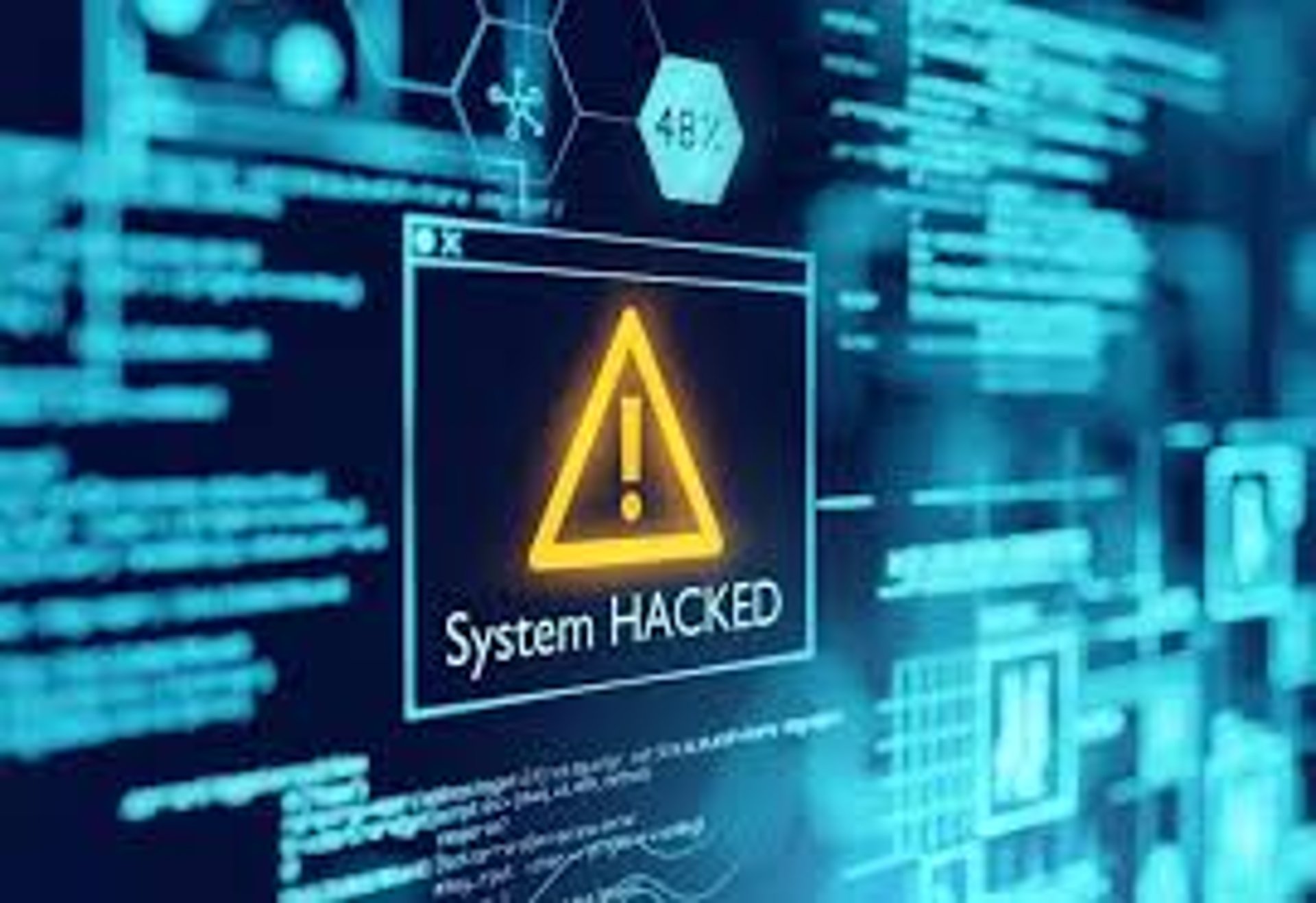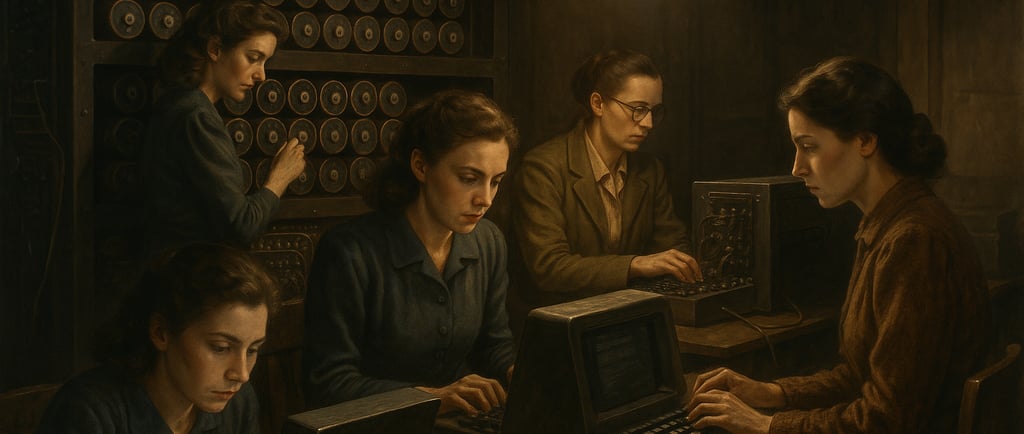
The Original Code Warriors
Women Who Hacked History
Shane Brown
7/11/20257 min read


The Original Code Warriors: Women Who Hacked History
Picture this: It's 1943, and while the world imagines brilliant male mathematicians hunched over complex machines, the real story is unfolding in secret facilities across America and Britain. In these classified locations, more than 10,000 women are quietly revolutionizing warfare through what we'd now recognize as the earliest forms of cybersecurity and code hacking. These weren't just typists or assistants, they were the original code warriors, comprising roughly 75% of the Allied codebreaking workforce and fundamentally changing the course of World War II.
Their story remained buried for decades under layers of government secrecy, but what's emerged is nothing short of extraordinary. These women didn't just support the war effort they were the war effort's secret weapon, breaking enemy communications that saved countless lives and shortened the conflict by an estimated two years.
The Secret Recruitment: Building an Army of Code Warriors
Long before Silicon Valley existed, the U.S. military was quietly recruiting the first generation of what we'd now call cybersecurity specialists. The recruitment process was as intriguing as any spy novel, with potential candidates approached through seemingly innocent questions: "Are you engaged to be married?" and "Do you like crossword puzzles?"
The ideal candidates answered "no" and "yes" respectively. The military wanted women who could relocate without personal complications and had minds that thrived on pattern recognition and complex problem-solving. These recruiters specifically targeted educated women with strong mathematical abilities and language skills, often approaching recent college graduates and schoolteachers who demonstrated exceptional analytical thinking.
The recruitment itself was shrouded in mystery. Women were told only that they would be "working for the government" with no details about their actual duties. Upon acceptance, they were immediately sworn to the strictest secrecy, with violations considered treason punishable by death during wartime. Many of these women carried their secrets for more than 70 years, taking their extraordinary contributions to the grave.
Bletchley Park: The Original Tech Hub
Bletchley Park in Britain operated like the world's first large-scale tech company, employing nearly 10,000 personnel at its peak in 1945. What made it remarkable wasn't just its size, but its workforce composition 75% women, most under 24 years old, recruited from diverse backgrounds through the Women's Services and Civil Service channels.
The working conditions would be familiar to anyone who's worked in a startup: temporary buildings that were freezing in winter and sweltering in summer, round the clock operations, and cutting edge technology that seemed impossibly complex. The women operated sophisticated machinery including the famous Bombe machines and later the revolutionary Colossus computers devices initially thought too advanced for women to handle.
When the Women's Royal Naval Service personnel, known as "Wrens," were brought in to operate these machines, they shattered every preconception about women's technical capabilities. They didn't just run the machines they understood them, maintained them, and in many cases, improved their operations.
The work required the same collaborative problem solving we see in modern tech teams. Women intercepted wireless transmissions, managed complex databases of information, and worked together to crack codes that had stumped traditional approaches. Their success proved that the most sophisticated technology of the era was best operated not by individual genius, but by diverse teams working in concert.
Arlington Hall: America's Code-Breaking Command Center
On the other side of the Atlantic, the United States established its primary Army codebreaking operations at Arlington Hall, a former women's college in Virginia transformed into a fortress-like facility surrounded by barbed wire and military barracks. This facility became America's answer to Bletchley Park, employing thousands of women who would earn the nickname "Code Girls."
Arlington Hall operated like a 24/7 tech operation, with three eight-hour shifts ensuring continuous monitoring and decryption of enemy communications. The scale was unprecedented—facilities routinely processed between 2,000 and 6,000 intercepted messages daily, handling German, Italian, Japanese, and Chinese communications.
The recruitment strategy was geographic and strategic. The Army focused efforts in the South among schoolteachers, while the Navy concentrated on elite women's colleges in the Northeast. These women flooded into Washington D.C. in numbers that fundamentally changed the city's character, pioneering new professional roles for women and delaying traditional life paths to serve their country.
Meanwhile, the Navy operated a parallel facility near American University, where hundreds of WAVES (Women Accepted for Volunteer Emergency Service) built and operated the Navy Cryptanalytic Bombe machines. These weren't simple devices they were massive 2.5-ton electromechanical computers designed to break the most sophisticated German encryption systems. Six hundred women worked in three shifts, seven days a week, learning to solder, wire, and assemble these complex machines, often without fully understanding their ultimate purpose.
The Code Warriors Who Changed History
Among the thousands of anonymous heroes, several women made contributions that directly altered the war's trajectory. Joan Clarke stands as perhaps the most accomplished, working alongside Alan Turing at Bletchley Park's Hut 8. A mathematics graduate from Cambridge, Clarke became deputy head of Hut 8 and was instrumental in developing methods to break German naval communications. Her team's breakthrough reduced Allied shipping losses from 282,000 tons per month to just 62,000 tons by November 1941 a victory that kept Britain supplied and fighting.
Virginia Dare Aderholt earned a unique place in history as the first American to learn that World War II had officially ended. Working at Arlington Hall as a Japanese language specialist, Aderholt intercepted, decrypted, and translated the Japanese surrender message on August 14, 1945. Her bilingual skills allowed her to simultaneously crack the code and understand its meaning, information that was immediately telephoned to military intelligence and reached President Truman within hours.
Agnes Meyer Driscoll, a former Texas mathematics teacher turned Navy cryptanalyst, became legendary within intelligence circles. Fluent in five languages with exceptional pattern recognition abilities, Driscoll spent years in the 1930s analyzing the Japanese Navy's fleet code. Her foundational work proved invaluable throughout the Pacific theater, providing crucial intelligence that helped the U.S. Navy anticipate and counter Japanese naval operations.
Margaret Rock and Mavis Batey broke barriers as among the few women formally recognized as cryptanalysts working at the same level as their male peers at Bletchley Park. Rock's work on German and Russian codes earned her recognition from veteran codebreaker Dilly Knox as "the fourth or fifth best in the whole of the Enigma staff." Batey's contributions to breaking Italian naval codes contributed directly to the Battle of Cape Matapan, effectively neutralizing the Italian Navy's role in the war.
The Digital Revolution That Saved the World
The intelligence these women provided wasn't just helpful it was war winning. Their codebreaking enabled Allied forces to anticipate enemy movements, coordinate devastating attacks on supply lines, and execute complex military operations with unprecedented precision. The information they decrypted allowed the Allies to target and kill Isoroku Yamamoto, the architect of Pearl Harbor, and provided crucial intelligence for the D-Day invasion of Normandy.
In the Pacific, American women codebreakers helped the U.S. Navy identify and sink virtually every Japanese supply ship heading to the Philippines and South Pacific. The systematic destruction of Japanese logistics, guided by intercepted and decrypted communications, starved Japanese forces and hastened the war's end.
The breaking of the German Enigma code, accomplished with massive contributions from women operators and cryptanalysts, is credited with shortening the war by approximately two years. At Bletchley Park, women's work on Naval Enigma messages enabled the development of methods to read all German naval communications, transforming submarine warfare from a German advantage into an Allied intelligence goldmine.
The numbers speak to the scale of their achievement: more than a million German naval messages were decrypted at Bletchley Park, many through the direct efforts of women operators and analysts. This massive intelligence operation provided Allied commanders with what modern military strategists would recognize as total information dominance the ability to know enemy plans before the enemy could execute them.
The Price of Secrecy
For decades after the war, these women's contributions remained locked away in classified files. Many adhered to their wartime oaths of silence for more than 70 years, even as they struggled to find post war employment without being able to explain their remarkable wartime achievements. Their job references deliberately obscured their contributions, stating only that they had "fulfilled their duties to utter satisfaction" bureaucratic language that gave no hint of how they had helped save the world.
This enforced silence came at a personal cost. These women had pioneered roles in what we now recognize as the technology sector, proving their capabilities in highly technical and intellectually demanding work. Yet they couldn't speak of their achievements, couldn't use their experience to advance their careers, and couldn't inspire the next generation of women to follow in their footsteps.
Legacy of the Original Code Warriors
The declassification of wartime documents in recent decades has finally illuminated these remarkable stories. Modern recognition reveals the profound irony that these women were pioneering the tech sector during an era when contemporary stereotypes suggest women aren't naturally suited for technical work. Their success in breaking complex codes, operating sophisticated machinery, and managing large, scale intelligence operations provides historical evidence that contradicts persistent gender biases in science and technology fields.
Their achievements resonate particularly strongly in our current digital age. These women were essentially the world's first cybersecurity specialists, the original ethical hackers who used their skills to defend democracy against authoritarianism. They understood that information could be weaponized, that communication networks were vulnerable, and that the ability to secure or compromise data could determine the fate of nations.
The Enduring Impact
The story of World War II's women codebreakers represents more than historical curiosity, it's a foundation story for the digital age. More than 10,000 women served in roles that directly prefigured modern cybersecurity, data analysis, and information technology careers. They broke enemy codes that saved countless lives, shortened a devastating war, and demonstrated capabilities that wouldn't be fully recognized for decades.
Their legacy extends beyond their wartime service to encompass broader questions about innovation, collaboration, and the diverse perspectives necessary for solving complex problems. In an era when cybersecurity threats emerge daily and digital literacy has become essential for national security, these women's achievements serve as both inspiration and evidence that protecting information requires the best minds available, regardless of gender.
As we face modern challenges in cybersecurity, artificial intelligence, and digital privacy, we can look back to these original code warriors who proved that the most sophisticated technology is best served by diverse teams of dedicated professionals. They cracked the codes that saved the world, and in doing so, they cracked open new possibilities for what women could achieve in technology and beyond.
Their story reminds us that behind every great technological achievement are real people—often unrecognized heroes whose contributions only become clear with time. In the case of World War II's women codebreakers, that recognition is long overdue, but their legacy continues to inspire new generations of code warriors facing the digital challenges of our time.
Innovate
Building websites and securing your digital presence.
Connect
Support
Info@sinistergatedesigns.com
© Sinister Gate Designs, LLC 2025. All rights reserved.
